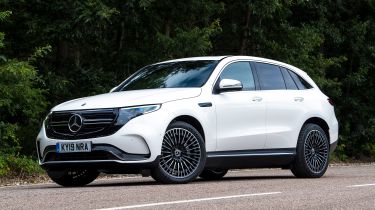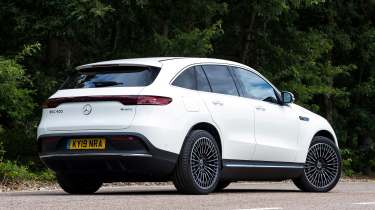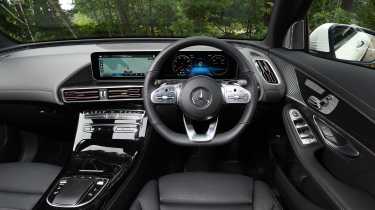Used Mercedes EQC (Mk1, 2019-2024) buyer’s guide: premium EV has its compromises
A full used buyer’s guide on the all-electric Mercedes EQC that was on sale between 2019 and 2024
Verdict
To accelerate the EQC’s development, Mercedes took its ICE-powered GLC and converted it to electric. While that keeps costs down (not that you’d know it from the list prices), it means compromises in terms of weight, interior space and practicality. But when we ran an EQC on our test fleet, it impressed with its refinement, luxury and hi-tech cabin, even if its efficiency left a bit to be desired, thanks to the car’s 2.5-tonne kerbweight. Expensive when new, the EQC is much more affordable as a used buy, due to the ravages of depreciation. Most car buyers are either pro-EV or anti-EV, with very few in between. If you’re in the former camp, we think that the Mercedes EQC is worth considering, as long as you’re aware of its limited practicality.
It was Mercedes that built the first car, way back in 1886, and the German company has never been afraid to innovate since then. It has produced some of the most technologically sophisticated and desirable models over the years, packed with safety and luxury technology.
Mercedes had dabbled with electric cars for years, but often only as prototype conversions of existing ICE-powered vehicles. It wasn’t until 2018 that the manufacturer unveiled its first purpose-built electric car: the EQC. Reflecting where consumer tastes lay, this was an SUV that would sit within a suite of Mercedes electric off-roaders, and it was as hi-tech and well made as you’d expect from the firm, while also being fast and enjoyable to drive. But are these qualities enough to tempt you into the company’s first EV?
History
The first EQCs reached showrooms in July 2019, priced from £65,640 for the EQC 400 4Matic Sport which, like all EQCs, was fitted with an 80kWh battery pack. There was a choice of four trim levels: Sport, AMG Line, AMG Line Premium and AMG Line Premium Plus. All versions were the same mechanically, which meant they had a 402bhp electric motor, which could also produce 760Nm of torque.
Used - available now

2020 BMW
4 Series
29,690 milesAutomaticPetrol3.0L
Cash £20,501
2023 Ford
Focus
21,621 milesManualPetrol1.0L
Cash £15,998
2023 Audi
e-tron
15,498 milesAutomaticElectric
Cash £23,158
2023 Audi
e-tron
29,621 milesAutomaticElectric
Cash £21,738At launch there were two special editions, both based on the Sport trim. The Edition 1 added an electric sliding roof, augmented-reality navigation, a Burmester surround-sound audio system, leather trim and 20-inch alloy wheels. The Edition 1886 had all these features plus the MBUX Interior Assistant, Driving Assistance and Parking packages with a 360-degree camera, memory seats and a head-up display.
Which one should I buy?
You don’t have too many choices to make, because with just one powertrain available, it’s a question of deciding which spec is right for you, and which colour; anything other than white was optional.
The entry-level Sport comes with 19-inch alloy wheels, self-levelling air suspension, keyless go, an electric tailgate, LED headlights, heated front seats with four-way electric adjustment, navigation, and front and rear parking sensors with a rear camera. The AMG Line has 20-inch alloys and AMG leather-trimmed sports seats, while the AMG Line Premium features 21-inch rims, an electric sliding sunroof, wireless phone charging, Apple CarPlay, Android Auto and a Burmester sound system. AMG Line Premium Plus offers all-around view, 12-way electric adjustment for the front seats and a head-up display.
Alternatives to the Mercedes EQC
There are many options if you want a mid-sized electric SUV, some of which were cheaper than the EQC when new, but not necessarily as a used buy.
The Jaguar I-Pace is readily available, fast, fun, luxurious and practical, while the BMW iX is great to drive but its exterior design is controversial; the smaller iX3 looks more conventional and it’s cheaper, too. The Ford Mustang Mach-E has a great interior and is good to drive, but it can’t match the Merc’s build quality, much like the Tesla Model X, which offers seven-seat practicality but is getting old now.
If you haven’t driven a Kia for a while, its EV6 will shatter your perceptions of the firm, much like the Hyundai Ioniq 5 will. There’s the closely related Genesis GV60, which offers exclusivity with a long range. Also check out the Audi e-tron and Skoda Enyaq.
What to look for
Charging
It takes nearly 41 hours to top up the battery from a home socket, 11 hours from a wallbox and 40 minutes on a 110kW charger.
Benefit
EQC buyers in the UK received a three-year subscription to the BP Chargemaster Polar charging network, later rebranded BP Pulse.
Four-wheel drive
All EQCs have 4Matic, which means the power is sent to all four wheels. Predictably, all EQCs have an automatic transmission.
Towing
A lot of electric vehicles are not able to tow anything at all, but the EQC can pull up to 1,800kg, although doing so will slash the Mercedes’ range.
Interior
If you’re switching from a Mercedes GLC, the EQC’s cabin will seem very familiar, because the two cars share a lot in terms of design and features. As a result the EQC’s dashboard seems rather conventional compared with some rivals’, although quality is very high. The way the MBUX infotainment system works and looks also impresses.
However, the amount of rear-seat headroom is not so good, even if the legroom is fine. Boot space is merely average, at 500 litres with the back seats in use, or 1,060 if you fold them down.
That puts the Mercedes’ load capacity at a disadvantage compared with its Jaguar I-Pace, BMW iX3 and Audi e-tron competitors.
Prices
There are more used EQCs for sale than you might expect. We found more than 400, so you shouldn’t have to travel far to buy one, bearing in mind how narrow the model range is. The various AMG Line editions account for virtually all of the second-hand EQCs on sale, although there are a few Sports available.
To check prices on a specific model head over to our free car valuation tool.
Running costs
All EQCs need to be serviced every 12 months or 15,000 miles, alternating between Minor and Major, or A and B in Mercedes parlance. These are priced at £235-£259 and £255-£370 respectively, depending on how many miles the car has done and therefore exactly which parts need to be replaced. In most instances the work required will be little more than checks for the tyres, suspension and brakes.
The brake fluid needs to be renewed every two years at a cost of £118, while the coolant has to be replaced every 10 years. Because that’s a way off for all EQCs, Mercedes couldn’t give us a price for this work to be done. The standard EQC warranty runs for three years with no mileage limit, but the battery is guaranteed for eight years or 100,000 miles.
Recalls
Mercedes has issued 15 recalls for the EQC so far, but six were for faulty eCall software that affected most of its model range. Cars involved were made up to January 2021 and the six actions were issued in May 2021.
The first campaign on the EQC came well before this, in November 2019, because of airbag glitches. The next three recalls came in 2020 and were due to sub-standard front axles (January), faulty rear-seat backrest locks (August) and power steering problems (December). There were four further actions in 2021, involving poorly sealed battery packs (July), faulty crash sensors (September), damaged wiring and further eCall maladies (both November).
The most recent recall was in June 2022, due to the potential for water to get into the headlight connectors.
Driver Power owner satisfaction
The EQC hasn’t appeared in a Driver Power new or used-car survey, although Mercedes normally has a few models in the countdown each year. There were just two cars in the 2023 new-car poll, with the A-Class finishing in 39th position and the E-Class in 43rd, and these placings are fairly typical. Mercedes rarely rates very highly; in 2022 there were four models in the poll, all ranked between 30th and 68th spot.









